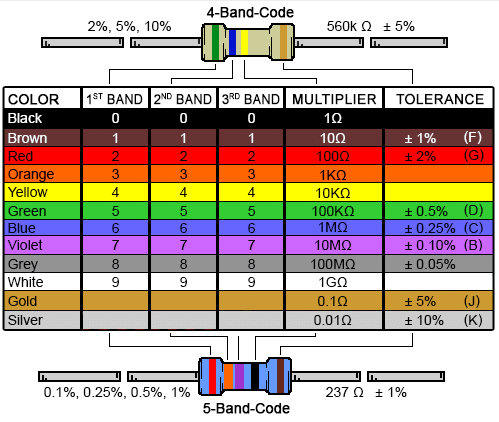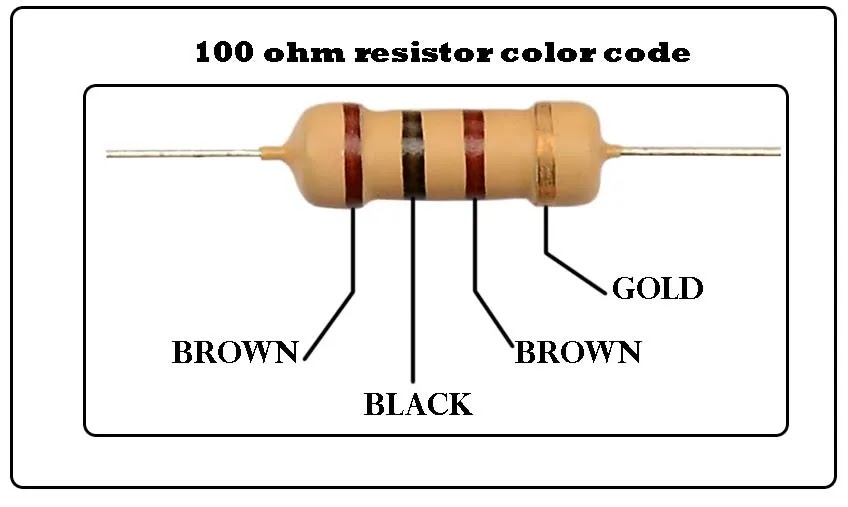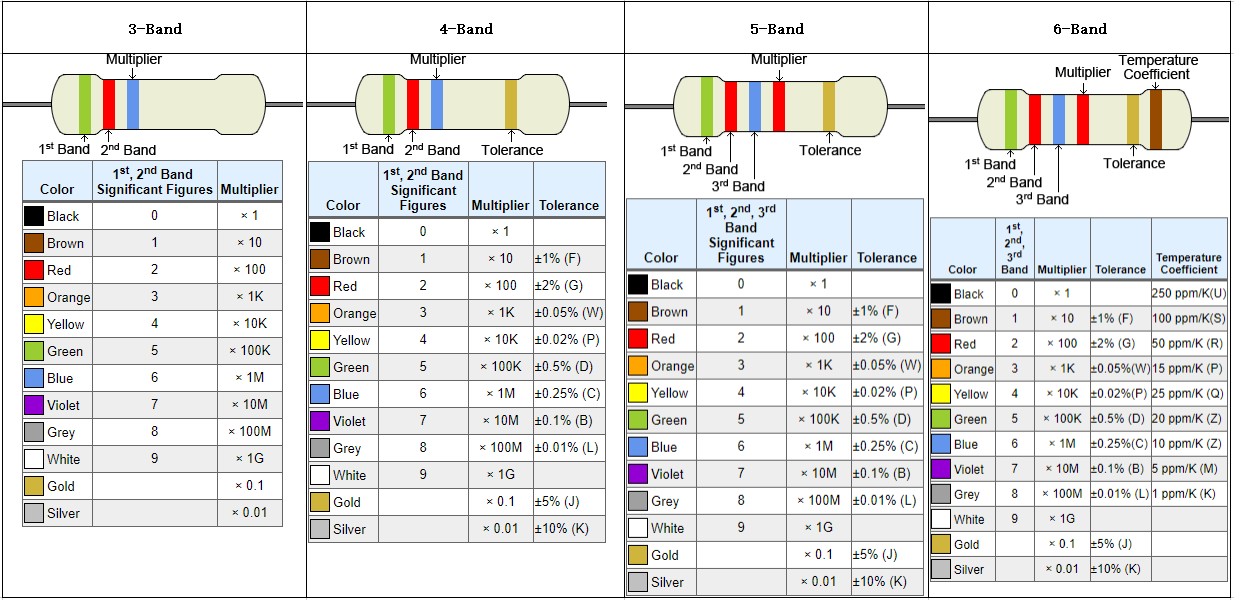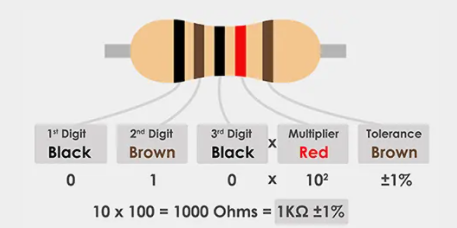
The Standard Resistor Color Code Chart
How to Use the Resistor Color Code Calculator
The online resistor calculator is a tool by ebee Electronic used to calculate resistor values for 4 band, 5 band, and 6 band resistors, in the range of ohms, Kilo Ohms, and Mega Ohms typically. And this resistance calculator is developed to calculate the color code using the resistor color codes on their surface.Just select the right color corresponding to each column and you can get the Resistor value on the right of the calculator immediately.
Examples: Calculating 10k/100 Ohm Resistor Color Code
Take a 4-band resistor as the example, 10k ohm resistor color code 4 band is: Brown-Black-Orange-Red. So the 1st band of Color: Brown, 2nd band: Black, Multiplier: Orange and Tolerance: Red. Thus, the output of resistor value is 10K ohms 2%. And the below picture shows you the 100 Ohm Resistor Color Code for 4-band resistors.

100 Ohm Resistor Color Code for 4-band
Introduction of Resistor
Resistors are usually used in electrical components with the aim of restricting the flow of electric current. They are usually tiny components with wire leads protruding from all sides. Resistors are special electronic components in circuits. It is made with the purpose of a precise quantity of electrical resistance.
The range of resistors may be from less than 1 Ohm (Ω) to over 20 mega Ohms (Ω) or 20 million Ohms (Ω). And there are two types of resistors: target="_self"> variable resistors and fixed resistors . A variable resistor can provide different values of resistance, however, the fixed resistor just has a single value. Meanwhile, there are 4 main classes of fixed resistors: carbon-composition resistors, Film resistors, wire wound resistors, and surface-mount resistors .
Resistor Color Bands
How to Read a Resistor Color Code Chart for 3/4/5/6 Band Resistors
Generally, the carbon-composition resistors have 3 to 6 resistor color bands . And the below electrical color code resistor chart shows you the resistor strips of the 3 band type, 4 band type, 5 and 6 band type. Compared with a 4-band resistor, a 5-band type is more precise because of its third significant digit. And a 6-band resistor has the 6th band, which is a temperature coefficient band.
From the following Resistor color code chart Calculator , we know that each color for resistor represents a number if it's found on 6-band and 5-band type from 1st to 3rd band or a 4-band resistor from the 1st to 2nd. And it is a multiplier if it is located on the 4th band of 5-band and 6-band type or the 3rd band of a 4-band resistor. You can get the tolerance values of a resistor on the 4th band for the 4-band type according to the 4 band resistor color code chart and the 5th for the 5-band and 6-band type through the below resistor color chart 5 band and 6 band. A 6-band type resistor has the 6th band, which shows you the temperature coefficient. And this value indicates how much the actual resistance value of this 6-band resistor changes when the temperature changes.

How To Read Resistor Color Code?
The easiest way to identify a resistor Color code is to know which colors represent the most significant digits. The following steps will guide you in reading a resistor color code.
1) Look for the colored bands on the resistor's body.
2) Determine which of these colors have a leading role in representing numbers.
3) Identify the numbers represented by these colors and their position.
4) Read off each of these digits from left to right on the band where it's located.
What is the purpose of resistor color codes?
Instead of written text, a color code is used to indicate the value, rating, or tolerance for very small electronic components.
Resistors are available in four, five, or more color bands, with a four-band color code being the most common. The first and second bands represent the first and second significant digits of the ohm value, respectively, while the third band represents the decimal multiplier. After that, there's a slight gap to help you distinguish between the component's left and right sides, followed by the fourth band, which indicates the resistor's tolerance.
Resistor Color Code Explained
4 band Resistor Color Code
IEC 60062 defines the color coding for resistors as an international standard. Different colors reflect significant figures, multiplier, resistance, reliability, and temperature coefficient in the resistor color code shown in the table below. The location of the color band on the resistor determines which of these the color refers to. There is a spacing between the third and fourth bands in a standard four-band resistor to show how the resistor should be read (from left to right, with the lone band after the spacing being the right-most band).
4 Band Resistors Color Code Table
| Color | 1 st Band (1 st Figure) | 2 nd Band (2 nd Figure) | 3 rd Band (Multiplier) | 4 th Band (Tolerance) | Temperature Coefficient |
|---|---|---|---|---|---|
| Black | 0 | 1 | 250 ppm/K(U) | ||
| Brown | 1 | 1 | 10 | ±1% (F) | 100 ppm/K(U) |
| Red | 2 | 2 | 100 | ±2% (G) | 50 ppm/K(U) |
| Orange | 3 | 3 | 1000 | ±0.05% (W) | 15 ppm/K(U) |
| Yellow | 4 | 4 | 10000 | ±0.02% (P) | 25 ppm/K(U) |
| Green | 5 | 5 | 100000 | ±0.5% (D) | 20 ppm/K(U) |
| Blue | 6 | 6 | 1000000 | ±0.25% (C) | 10 ppm/K(U) |
| Violet | 7 | 7 | 10000000 | ±0.1% (B) | 5 ppm/K(U) |
| Grey | 8 | 8 | 100000000 | ±0.05% (L) | 1 ppm/K(U) |
| White | 9 | 9 | 1000000000 | ||
| Gold | 0.1 | ±5% (J) | |||
| Silver | 0.01 | ±10% (K) | |||
| None | ±20% (M) |
4-band resistor color code chart
Significant figure component:
four-band resistor
The first and second bands in a standard four-band resistor reflect significant figures. Refer to the figure above with the green, red, blue, and gold bands for this illustration. The green band represents the number 5 in the table below, while the red band represents the number 2.
Multiplier:
The third, blue band, is the multiplier. Using the table, the multiplier is thus 1,000,000. This multiplier is multiplied by the significant figures determined from the previous bands, in this case, 52, resulting in a value of 52,000,000 Ω, or 52 MΩ.
The multiplier is the third, blue band. The multiplier is therefore 1,000,000 when using the table. This multiplier is multiplied by the significant figures calculated from the previous bands, in this case, 52, for a value of 52,000,000 Ω (or 52 MΩ).
Tolerance:
The fourth band isn't always visible, but when it is, it stands for tolerance. The resistor value can be varied by this percentage. In this case, the gold band shows a tolerance of 5%, which is indicated by the letter J. As a result, the value 52 MΩ will differ by up to 5% in either direction, resulting in a resistor value of 49.4 MΩ - 54.6 MΩ.
Resistor Color Code 5 Band
The 5 band code is used to produce precise and high-quality resistors with tolerances of 1%, 2%, or less. The regulations are the same as in the previous system, with the exception of the number of digit bands. The first three bands will represent the value, the fourth will be the multiplier, and the fifth will be the tolerance.
Band (optional)
A few resistors include an extra band that indicates either the dependability or the temperature coefficient, which might be confusing for novices.
The failure rate per 1000 hours is specified by the reliability band (assuming that a full wattage being applied to the resistor). This stripe is most commonly found on 4-band resistors designed for military purposes and is rarely seen in consumer circuits.
Temperature coefficients are becoming more frequent, particularly on high-quality 5-band resistors, as they become an essential element in precision components. For a resistor with a temperature coefficient of 200 ppm, a temperature change of 50°C results in a 1% change in value. The color chart above shows the most frequent values for this band.
5 Band Resistors Color Code Table
| Color | 1 st Band (1 st Figure) | 2 nd Band (2 nd Figure) | 3 rd Band (3 rd Figure) | 4 th Band (Multiplier) | 5 th Band (Tolerance) |
|---|---|---|---|---|---|
| Black | 0 | 0 | x 1 | ||
| Brown | 1 | 1 | 1 | x 10 | ±1% |
| Red | 2 | 2 | 2 | x 100 | ±2% |
| Orange | 3 | 3 | 3 | x 1k | |
| Yellow | 4 | 4 | 4 | x 10k | |
| Green | 5 | 5 | 5 | x 100k | ±0.5% |
| Blue | 6 | 6 | 6 | x 1M | ±0.25% |
| Violet | 7 | 7 | 7 | x 10M | ±0.1% |
| Grey | 8 | 8 | 8 | x 100M | ±0.05% |
| White | 9 | 9 | 9 | x 1G | |
| Gold | 0.1 | ±5% | |||
| Silver | 0.01 | ±10% |
Five band Resistor Color Code Examples:

5-band resistor has colors: Black-Brown-Black-Red-Brown.
The values as, 0/1//0/102 = 10 * 100 = 1K ohm/1K, with a tolerance is ±1% for Brown. Therefore, the resistor value is 900Ω to 1.01KΩ
More examples of 5-band resistance color code:
A resistor colored Blue-Brown-White-Brown-Red
The values as, 6/1//9/10 = 619 x 10 = 6190 ohms (6.19K ohms). The tolerance is ±2% for Red. Thus, the resistor value is 6.07KΩ-6.31KΩ
6 Band Resistor Color Code
For high precision, Resistors with 6 bands usually have 6 band color codes. And mostly, the 6th band is colored with brown, which means that the resistance value can change 1000 ppm = 0.1%, for a temperature change of 10 ˚C. For example, a 6 band resistor colored Orange-Red-Brown-Brown-Green-Red would be 3.21 kΩ with a tolerance of ±1% and a 50 ppm/°C temperature coefficient.
Standard EIA Decade Resistor Values
The values of resistors are divided into a number of distinct series of recommended or standard resistor values.
The varied values can be spaced in such a way that they relate to the component tolerance or accuracy since the standard resistor values have a logarithmically based sequence.
Tolerances for resistors are typically 20%, 10%, 5%, 2%, and 1% respectively. For some resistors, more precise tolerances are possible, although they are not as readily accessible and cost more.
Electronic components from a range of manufacturers may be used thanks to these standard resistor values, making sourcing considerably easier and lowering component costs.
EIA PREFERRED OR STANDARD RESISTOR VALUE SERIES
| E SERIES | TOLERANCE (SIG FIGS) | NUMBER OF VALUES IN EACH DECADE |
|---|---|---|
| E3 | >20% | 3 |
| E6 | 20% | 6 |
| E12 | 10% | 12 |
| E24 | 5% [normally also available in 2% tolerance] | 24 |
| E48 | 2% | 48 |
| E96 | 1% | 96 |
| E192 | 0.5%, 0.25% and higher tolerances | 192 |
The varied values throughout each decade can be described in a tabular form using the EIA recommended values or standard resistor values.
Despite the fact that current resistor technology allows for extremely tight tolerance levels, there is still a significant benefit to employing resistors from the E3 series. It streamlines the purchasing and production procedures by reducing the number of various types of resistors used in a design. Typically, designs strive to stick to the E3 or E6 standard resistor values, only employing the E12, E24, E48, or E96 if absolutely necessary.
Digital design, where a pull up or pull down resistor is required, is one example where values can be maintained inside the E3 series. The precise value is unimportant; just a value within the approximate range is required. The value of these resistors can be chosen from the E3 series.
Although a little more freedom is required for analogue designs, common resistor values such as E6 or E12 may be employed without issue in most electronic circuit designs. For high precision and close tolerance requirements, E24, E48, E96, or even E192 series values may be required on occasion: filters, oscillators, measurement applications, and so on.
E3 STANDARD RESISTOR SERIES
Because the E3 series resistors are the most regularly utilized, they are the most often used resistor values in the electronics sector. They're especially beneficial for resistor settings that aren't crucial in any manner. The number of distinct components in any electronic circuit design may be minimized by sticking to this series, which can assist lower manufacturing costs by decreasing inventory and the additional administration and setup necessary for additional component types in a design.
E6 STANDARD RESISTOR SERIES
In the industry, the E6 series resistor values are also commonly utilized. They provide you a greater choice of resistor values to choose from.
E12 STANDARD RESISTOR SERIES
Each subsequent resistor in the E12 series is within ten percent of the prior value. Until recently, 10% tolerance resistors were the standard, but 5 percent (E24) resistors appear to be the most used nowadays. Although they may still be found in ancient radios and amplifiers, the cost of a 5% resistor is low enough to make it the standard component in all modern electronic circuits.
Special, more expensive low-tolerance resistors with tolerance values of 2%, 1%, or less are utilized in precision applications.
E24 STANDARD RESISTOR SERIES
The following is a comprehensive list of all E24 series resistors, including shorthand notation, tolerance range, and color coding, ranging from 0.1 ohm to 10 M ohms.
For the E24 series, the fourth band is usually gold (5 percent tolerance). A fifth band may be present, representing the temperature coefficient or dependability. See also the theory behind resistor color coding and the resistor color to value and value to color code calculators for 3, 4, and 5 bands resistors.
E48 STANDARD RESISTOR SERIES
The following is a comprehensive list of all E48 series resistors, including shorthand notation, tolerance range, and color code, ranging from 0.10 ohm to 10.0 M ohms.
For the E48 series, the fifth band is always red (2 percent tolerance). A sixth band may be present, showing the temperature coefficient or dependability. See also the logic behind conventional resistor color coding and the resistor color code calculator for 3, 4, and 5 bands.
E96 STANDARD RESISTOR SERIES
1 ohm resistor color code 4 band resistor is brown - black - gold - [Tolerance].
The color code for 1 ohm resistor 5 band is brown - black - black - silver - [Tolerance].
10 ohm resistor color code 4 band resistor is brown - black - black - [Tolerance].
The color code of the 10 ohm resistor with 5 band is brown - black - black - gold - [Tolerance].
100 ohm resistor color code of 4 band resistor is brown - black - brown - [Tolerance].
The color code of the 100 ohm resistor with 5 band is brown - black - black - black - [Tolerance].
1k resistor color code of 4 band resistor is brown - black - red - [Tolerance].
1k ohm resistor Color Code 5 band (namely 1000 ohm resistor color code 5 band) is brown - black - black - brown - [Tolerance].
10k resistor color code of 4 band resistor is brown - black - orange - [Tolerance].
The color code of the 10k ohm resistor with 5 band is brown - black - black - red - [Tolerance].
100k ohm resistor color code of 4 band resistor is brown - black - yellow - [Tolerance].
The color code of the 100k ohm resistor with 5 band is brown - black - black - orange - [Tolerance].
1M ohm resistor color code of 4 band resistor is brown - black - green - [Tolerance].
The color code of the 1M ohm resistor with 5 band is brown - black - black - yellow - [Tolerance].
10M ohm resistor color code of 4 band resistor is brown - black - blue - [Tolerance].
The color code of the 10M ohm resistor with 5 band is brown - black - black - green - [Tolerance].
The color code of the 1.01 ohm resistor for is brown - black - brown - silver - [Tolerance].
1.02 ohm resistor color code for 5 band resistor is brown - black - red - silver - [Tolerance].
1.04 ohm 5 band resistor color code is brown - black - yellow - silver - [Tolerance].
The color code of the 1.05 ohm resistor with 5 band is brown - black - green - silver - [Tolerance].
1.06 ohm resistor color code is Brown - Black - Blue - Silver - [Tolerance].
120 ohm resistor color code is Brown - Red - Brown - Golden - [Tolerance].
150 ohm resistor color code is Brown - Green - Brown - Golden - [Tolerance].
2.2k resistor color code 4 band is Red - Red - Red - [Tolerance].
2.2k ohm resistor color code 5 band is Red - Red - Red - Gold/Silver.
20k ohm resistor color code is Red - Black - Orange - Golden
220 resistor color code 4 band resistors is Red - Red - Brown - [Tolerance](Gold for 5% tolerance and Silver for 10% tolerance).
220 ohm resistor color code 5 band is red - red - black - black - [Tolerance].
20k resistor color code is red - black - orange - [Tolerance].
22k resistor color code 4 band is red - red - orange - [Tolerance].
2200 ohm resistor color code 5 band is red - red - black - red - [Tolerance].
330 Ohm Resistor Color Code for 4-band resistor is Orange-Orange-Brown-Golden(tolerance is 5%).
3.3 k resistor color code 4 band is Orange - Orange - Red - Golden.
3.3k resistor color code 5 band is orange - orange - black - brown - [Tolerance].
33k resistor color code is Orange - Orange - Orange - Golden.
470 ohm resistor color code is Yellow - Violet - Brown - Golden.
15k resistor color code is Brown - Green - Orange - Golden.
47 k resistor color code 4 band is yellow - purple - orange - [Tolerance].
47k resistor color code 5 band is yellow - purple - black - red - [Tolerance].
4.7k ohm resistor color code 4 band is yellow - purple - red - [Tolerance].
4.7 k resistor color code 5 bands is yellow - purple - black - brown - [Tolerance].
50 ohm resistor color code is Brown - Red - Orange - [Tolerance]
500 ohm resistor color code is Green - Brown - Brown - [Tolerance](the 500 ohm resistor is a nonstandard value of resistor, so use the 510 ohm resistor color code instead.)
5.6k resistor color code (also 5k6 ohm resistor color code) is Green - Blue - Red - [Tolerance].
6k8 ohm resistor color code (namely 6.8 k resistor color code) is Blue - Gray - Red - [Tolerance].